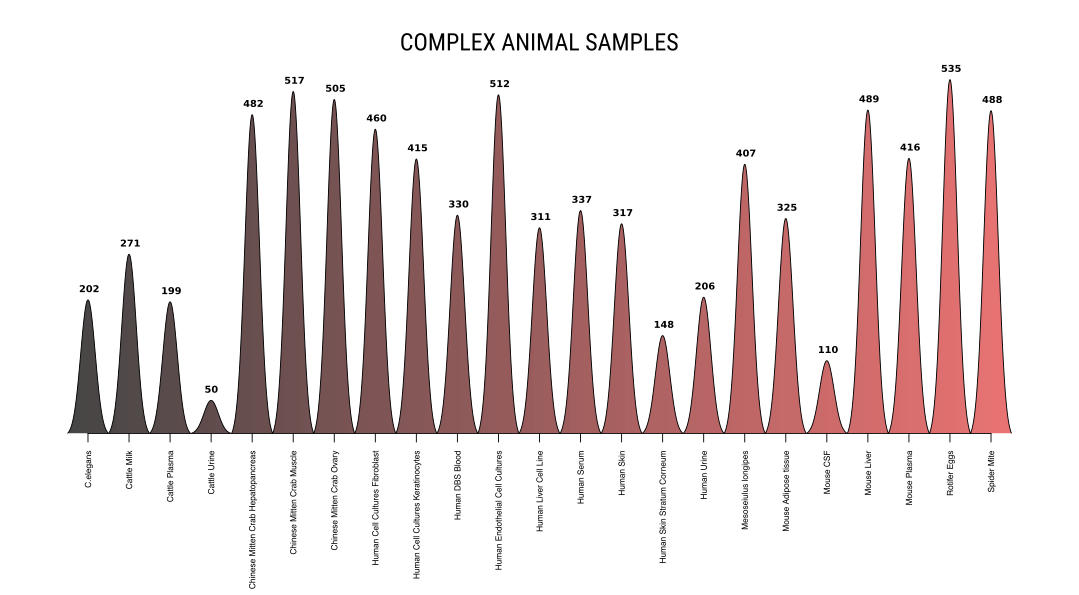Lipidomics Detection
Ultra Performance Liquid Chromatography coupled with Mass Spectrometry (UPLC-MS) is a powerful tool for lipidomics, enabling high-throughput and high-resolution analysis of lipid species.
By employing reversed-phase chromatography (C8), lipid separation is significantly improved, reducing sample complexity and enhancing the detection coverage across diverse lipid groups and individual lipid species.
This technique allows for the profiling of up to 23 lipophilic compounds and lipid classes, each comprising numerous unique lipid molecules.
Untargeted
LC-MS and LC-MS/MS Method
Most common class of compounds detected:
Fatty acids:
Alpha-Linolenic acid (FA 18:3)
Behenic acid (FA 22:0)
Palmitoleic acid (FA 16:1)
Oleic acid (FA 18:1)
Stearic acid (FA 18:0)
Erucic acid (FA 22:1)
Nervonic acid (FA 24:1)
Gondoic acid, FA 19:0, FA 17:0, etc.
Sphingolipids & related:
Dihydrosphingosine
Phytosphingosine
Sphingosine
Our lipidomic platform will help you to answer a biological question, from analyzing the skin lipidome to profiling the lipid compositions of plants tissues, microorganisms and membranes. Whether you're studying changes in lipid composition or investigating specific compartments, our method provides key information about lipidome.
If you're exploring how a particular compound affects lipid composition, our lipidomic analysis can reveal which metabolites are altered in response to treatment. The metSysX pipeline is a robust and validated workflow that enables the detection of a wide panel of lipid types, including fatty acids, glycolipids, sphingolipids, sterol esters, ether-linked lipids, carnitines, ceramides, sphingomyelins, and free sterols. The wide dynamic range and the possibility to optimize the pipeline for different amounts facilitate detection of less abundant lipids.
Each sample is injected twice and measured in LC-MS positive and negative ionization mode, which leads to one of the most comprehensive detections of lipids worldwide. For each experiment, a couple of samples are measured additionally in tandem mass spectrometry (LC-MS/MS) positive and negative ionization modes. The obtained fragmentation spectrum enhances the annotation level and results in the highest coverage of annotated lipids.
the combination of annotations procedures using the lipids database and the fragmentation spectrum result in detection of following lipids
The combination of annotations procedures using the lipids database and the fragmentation spectrum result in detection of following lipids
Fatty acids: Alpha-Linolenic acid (FA 18:3), Behenic acid (FA 22:0), Palmitoleic acid (FA 16:1), Oleic acid (FA 18:1), Stearic acid (FA 18:0), Erucic acid (FA 22:1), Nervonic acid (FA 24:1), Gondoic acid, FA 19:0, FA 17:0, etc.
Sphingolipids & related: Dihydrosphingosine, Phytosphingosine, Sphingosine
Phospholipids: lysoPC, lycoPE, PE, PC, PG, ether-linked lysoPC, ether-linked lysoPE, ether-linked PC
Galactolipids: MGDGD, DGDGD, SQDG
Get a Quote


